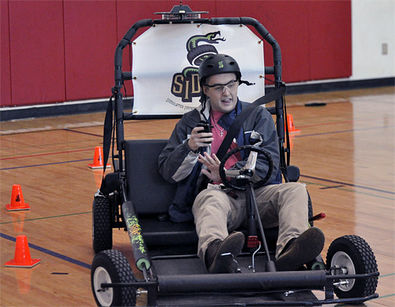Riverside High School senior Read Williford thought he had everything under control.
After all, he was only maneuvering a go-kart at a very slow speed inside a small auxiliary gymnasium with cones strategically placed and he was being monitored by Greer Police Department officers.
A helmet and seat belt were required safety precautions for each driver.
“You’re going into the wall,” yelled a classmate. Interestingly there were no noticeable giggles, although there were some hands cupped on mouths expecting an imminent crash.
“The wheels were going way to fast,” Williford said. “I looked up and tried to spin a little away from the wall, but…”
Williford wasn’t pushing the boundaries of SIDNE (Simulated Impaired Driving Experience). This was a one-hour demonstration of what sometimes can be a deadly consequence of texting and driving.
Williford said he didn’t need any reminders. He lost a high school friend who died in an automobile crash. There was suspicion that the driver was allegedly texting at the time of the crash.
“What happened to my friend was a shocker,” Williford said. “You hear about it (texting while driving) and people warn you but until something like that happens a lot of my friends don’t think it can happen to them.”
Williford said his parents have discussed texting and driving and have put safeguards in place that he understands is for his benefit.
“My parents are strict. My mother would call me on my cell phone to listen if I was driving and talking on the phone the same time. I don’t text and drive and I even get nervous when I look at the phone or text while in the car,” Williford said.
There are applications available that let parents disable cell-phone use while teens drive. “Some of my friends have that on their phone,” Williford said. “I’m for anything that helps keep my friends safe.”
Stephanie Smith, Riverside Athletic Director, asked for the use of SIDNE. The classes were students in honor classes or in leadership roles at the school.
Smith said it was interesting in that the students didn’t volunteer to drive SIDNE. “They were gung-ho when they got here. They were afraid to do it because they didn’t want the realization this is not good. They didn’t want to know how dangerous it was. But I can assure you the message was already being delivered around the school after today’s first session. The students are good about disseminating information.”
Sgt. Perry Bowens, a high school resource officer, and Sgt. Chad Richardson, Community Outreach, were among the officers attending the session that Williford was participating. Sgt. Randle Ballenger had control of the go-kart to make conditions faster or steering more hazardous.
SIDNE is a popular training tool for all driving ages. It’s more often used outdoors on larger courses but a morning rain forced these training sessions indoors. The go-kart is remote controlled to simulate drinking and driving conditions. It forces drivers to speed up reacting to conditions and when multi-tasking.
While Williford was driving, two classmates were positioned to text him to simulate the conditions of looking down and losing focus on the course. He ran over several cones while glancing down at his phone and that’s when he almost went head-on into the concrete wall.
Richardson, who frequently assists resource officers, said SIDNE is the closest thing to reality to convince students the perils of multi-tasking on cellphones while driving. “These kids, it will sink in,” Richardson said, watching the students observe the drivers. “When a kids actually put their hand on the wheel in circumstances like these, they get it.’
